Water Sorption and Solubility of Flowable Giomers
Abstract
1. Introduction
2. Materials and Methods
2.1. Studied Materials
Experimental Light-Curing Giomer Fabrication
2.2. Water Sorption and Water Solubility
2.3. Microstructural Analysis of Giomer Surfaces by Scanning Electron Microscopy (SEM) and Atomic Force Microscopy (AFM)
2.3.1. Scanning Electron Microscopy (SEM)
2.3.2. Atomic Force Microscopy (AFM)
2.4. Statistical Analysis
3. Results
3.1. Water Sorption and Water Solubility
3.1.1. Water Sorption
3.1.2. Water Solubility
3.1.3. Statistical Analyses of Water Sorption and Solubility
3.2. Microstructural Analysis of Giomers Surfaces by SEM and AFM
3.2.1. Microstructural Analysis of Giomers Surfaces by SEM
3.2.2. Microstructural Analysis of Giomers Surfaces by AFM
4. Discussion
5. Conclusions
Author Contributions
Funding
Institutional Review Board Statement
Informed Consent Statement
Data Availability Statement
Acknowledgments
Conflicts of Interest
References
- Rusnac, M.E.; Gasparik, C.; Irimie, A.I.; Grecu, A.G.; Mesaros, A.I.; Dudea, D. Giomers in dentistry—At the boundry between dental composites and glass-ionomers. Med. Pharm. Rep. 2019, 92, 123–128. [Google Scholar] [CrossRef] [PubMed]
- Ikemura, K.; Tay, F.R.; Endo, T.; Pashley, D.H. A review of chemical-approach and ultramorphological studies on the development of fluoride-releasing dental adhesives comprising new pre-reacted glass ionomer (PRG) fillers. Dent. Mater. J. 2008, 27, 315–339. [Google Scholar] [CrossRef] [PubMed]
- Abdel-Karim, U.M.; El-Eraky, M.; Etman, W.M. Three-year clinical evaluation of two nano-hybrid giomer restorative composites. Tanta Dent. J. 2014, 11, 213–222. [Google Scholar] [CrossRef]
- Gonulol, N.; Ozer, S.; Sen Tunc, E. Water sorption, solubility, and color stability of giomer restoratives. J. Esthet. Restor. Dent. 2015, 27, 300–306. [Google Scholar] [CrossRef] [PubMed]
- Saba, D.A.; Abdel Gawad, F.K.; Abd Ellatif, M.A. In vitro assessment of water sorption, solubility and surface roughness of compomer and giomer materials after immersion in different beverages. Egypt. Dent. J. 2017, 63, 205–214. [Google Scholar] [CrossRef][Green Version]
- Colceriu Burtea, L.; Prejmerean, C.; Prodan, D.; Baldea, I.; Vlassa, M.; Filip, M.; Moldovan, M.; Antoniac, A.; Prejmerean, V.; Ambrosie, I. New pre-reacted glass containing dental composites (giomers) with improved fluoride release and biocompatibility. Materials 2019, 23, 4021. [Google Scholar] [CrossRef]
- BEAUTIFIL Flow Plus; Injectable Hybrid Restorative Material. Available online: https://www.shofu.com.sg/wp-content/uploads/2020/02/Beautifil-Flow-Plus-BRO.pdf (accessed on 7 March 2021).
- BEAUTIFIL Flow; Flowable Filling Material for Aesthetic Restorations. Available online: https://www.shofu.de/wp-content/uploads/2018/06/Beautifil-Flow-Info-UK.pdf (accessed on 7 March 2021).
- Harhash, A.Y.; ElSayad, I.I.; Zaghloul, A.G. A comparative in vitro study on fluoride release and water sorption of different flowable esthetic restorative materials. Eur. J. Dent. 2017, 11, 174. [Google Scholar] [CrossRef]
- Rusnac, M.E.; Gasparik, C.; Delean, A.G.; Aghiorghiesei, A.I.; Dudea, D. Optical properties and masking capacity of flowable giomers. Med. Pharm. Rep. 2021, 94, 99–105. [Google Scholar] [CrossRef]
- Hamouda, I.M. Effects of various beverages on hardness, roughness, and solubility of esthetic restorative materials. J. Esthet. Restor. Dent. 2011, 23, 315–322. [Google Scholar] [CrossRef]
- Prejmerean, C.; Moldovan, M.; Silaghi-Dumitrescu, L.; Prodan, D.; Furtos, G.; Trif, M.; Popescu, V.; Pascalau, V.; Petrea, C.M.; Silaghi-Dumitrescu, R. Composition versus physico-mechanical properties of some dental experimental polymers. Mater. Plast. 2011, 48, 27–32. [Google Scholar] [CrossRef]
- Prejmerean, C.; Prodan, D.; Vlassa, M.; Streza, M.; Buruiana, T.; Colceriu, L.; Prejmerean, V.; Cuc, S.; Moldovan, M. ATR technique, an appropriate method for determining the degree of conversion in dental giomers. Meas. Sci. Technol. 2016, 27, 124008. [Google Scholar] [CrossRef]
- ISO 4049:2019. Dentistry—Polymer-Based Restorative Materials; International Organization for Standardization: London, UK, 2019; Available online: https://www.iso.org/standard/42898.html (accessed on 7 March 2021).
- McCabe, J.F.; Rusby, S. Water absorption, dimensional change and radial pressure in resin matrix dental restorative materials. Biomaterials 2004, 25, 4001–4007. [Google Scholar] [CrossRef]
- Najma Hajira, N.S.W.; Meena, N. GIOMER—The Intelligent Particle (New Generation Glass Ionomer Cement). Int. J. Dent. Oral Health 2015, 2, 1–5. [Google Scholar] [CrossRef]
- EL-Sharkawy, F.M.; Zaghloul, N.M.; Ell-kappaney, A.M. Effect of water absorption on color stability of different resin based restorative materials in vitro study. Int. J. Compos. Mater. 2012, 2, 7–10. [Google Scholar] [CrossRef][Green Version]
- Ito, S.; Hashimoto, M.; Wadgaonkar, B.; Svizero, N.; Carvalho, R.M.; Yiu, C.; Rueggeberg, F.A.; Foulger, S.; Saito, T.; Nishitani, Y.; et al. Effects of resin hydrophilicity on water sorption and changes in modulus of elasticity. Biomaterials 2005, 26, 6449–6459. [Google Scholar] [CrossRef]
- Malacarne, J.; Carvalho, R.M.; Mario, F.; Svizero, N.; Pashley, D.H.; Tay, F.R.; Yiu, C.K.; de Oliveira Carrilho, M.R. Water sorption/solubility of dental adhesive resins. Dent. Mater. 2006, 22, 973–980. [Google Scholar] [CrossRef]
- Sokolowski, K.; Szczesio-Wlodarczyk, A.; Bociong, K.; Krasowski, M.; Fronczek-Wojciechowska, M.; Domarecka, M.; Sokolowski, J.; Lukomska-Szymanska, M. Contraction and Hydroscopic Expansion Stress of Dental Ion-Releasing Polymeric Materials. Polymers 2018, 10, 1093. [Google Scholar] [CrossRef]
- Ferracane, J.L. Hygroscopic and hydrolytic effects in dental polymer networks. Dent. Mater. 2006, 22, 211–222. [Google Scholar] [CrossRef]
- Ferracane, J.L.; Palin, W.M. Effects of particulate filler systems on the properties and performance of dental polymer composites. In Non-Metallic Biomaterials for Tooth Repair and Replacement; Elsevier: Amsterdam, The Netherlands, 2012; pp. 294–335. [Google Scholar]
- Misilli, T.; Gönülol, N. Water sorption and solubility of bulk-fill composites polymerized with a third generation LED LCU. Braz. Oral Res. 2017, 31. [Google Scholar] [CrossRef]
- Soanca, A.; Bondor, C.I.; Moldovan, M.; Roman, A.; Romînu, M. Water Sorption and Solubility of an Experimental Dental Material: Comparative Study. Appl. Med. Inform. 2011, 29, 27–33. [Google Scholar] [CrossRef]
- Örtengren, U.; Wellendorf, H.; Karlsson, S.; Ruyter, I.E. Water sorption and solubility of dental composites and identification of monomers released in an aqueous environment. J. Oral Rehabil. 2001, 28, 1106–1115. [Google Scholar] [CrossRef]
- Fabre, H.S.; Fabre, S.; Cefaly, D.F.; de Oliveira Carrilho, M.R.; Garcia, F.C.; Wang, L. Water sorption and solubility of dentin bonding agents light-cured with different light sources. J. Dent. 2007, 35, 253–258. [Google Scholar] [CrossRef]
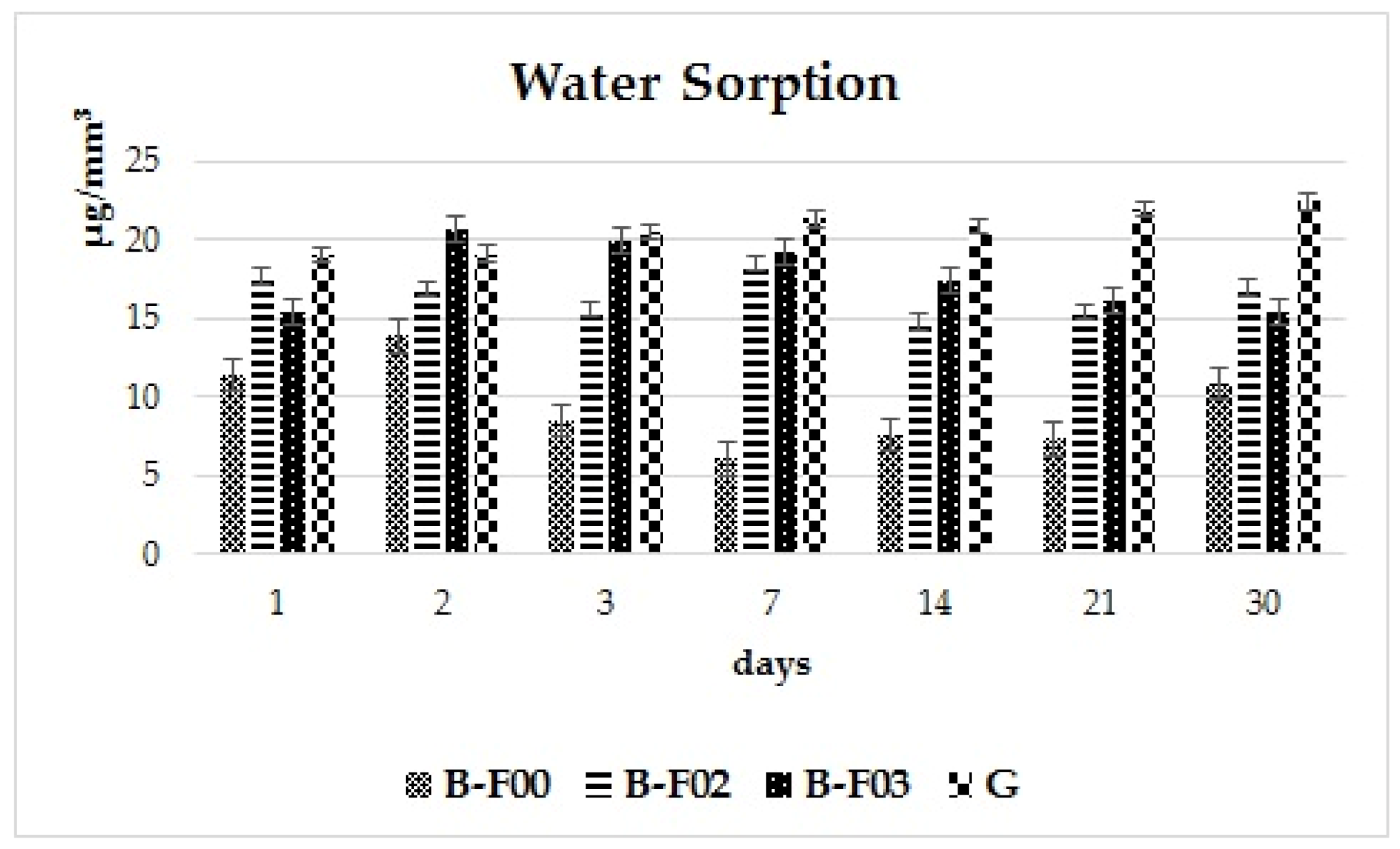
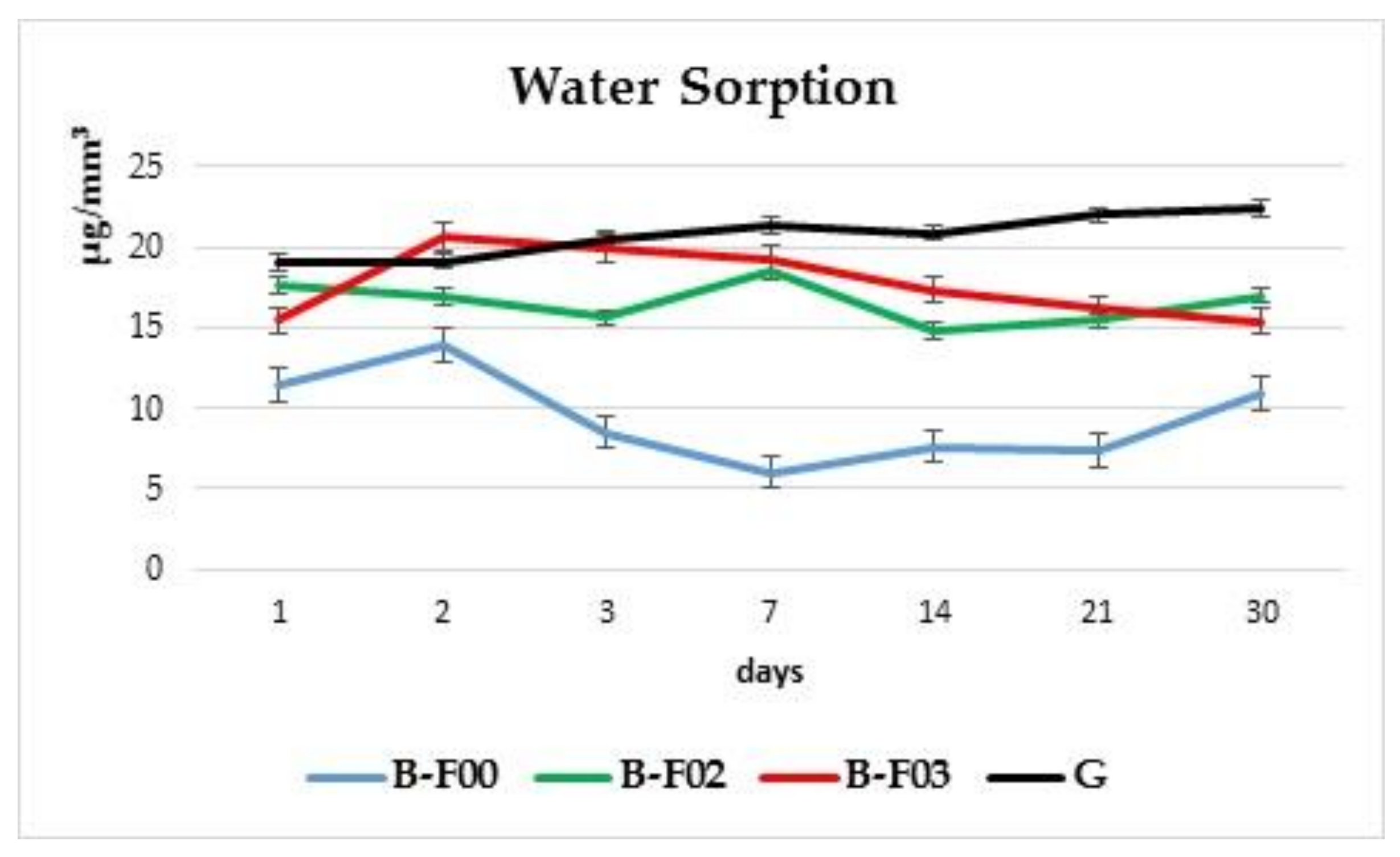
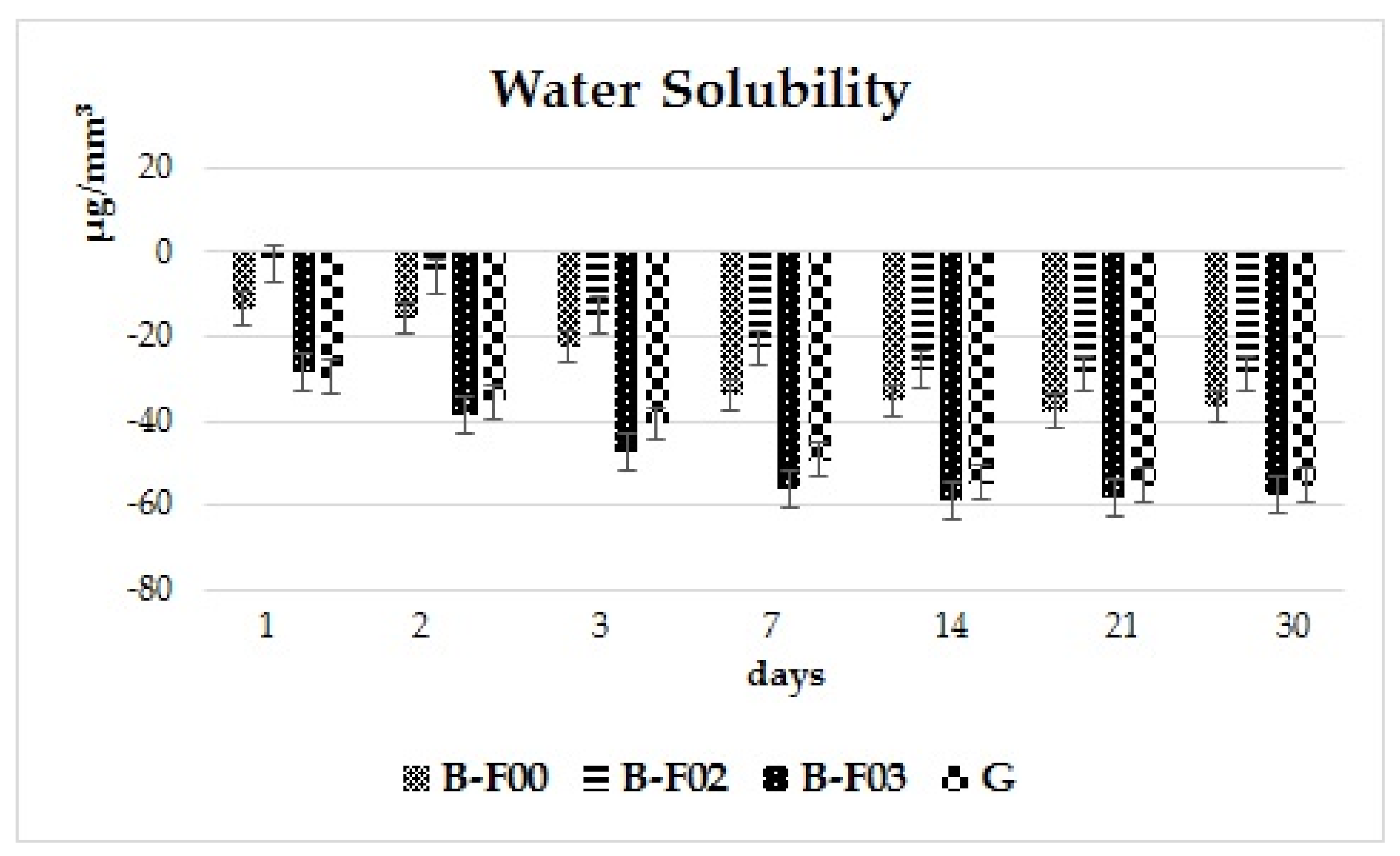
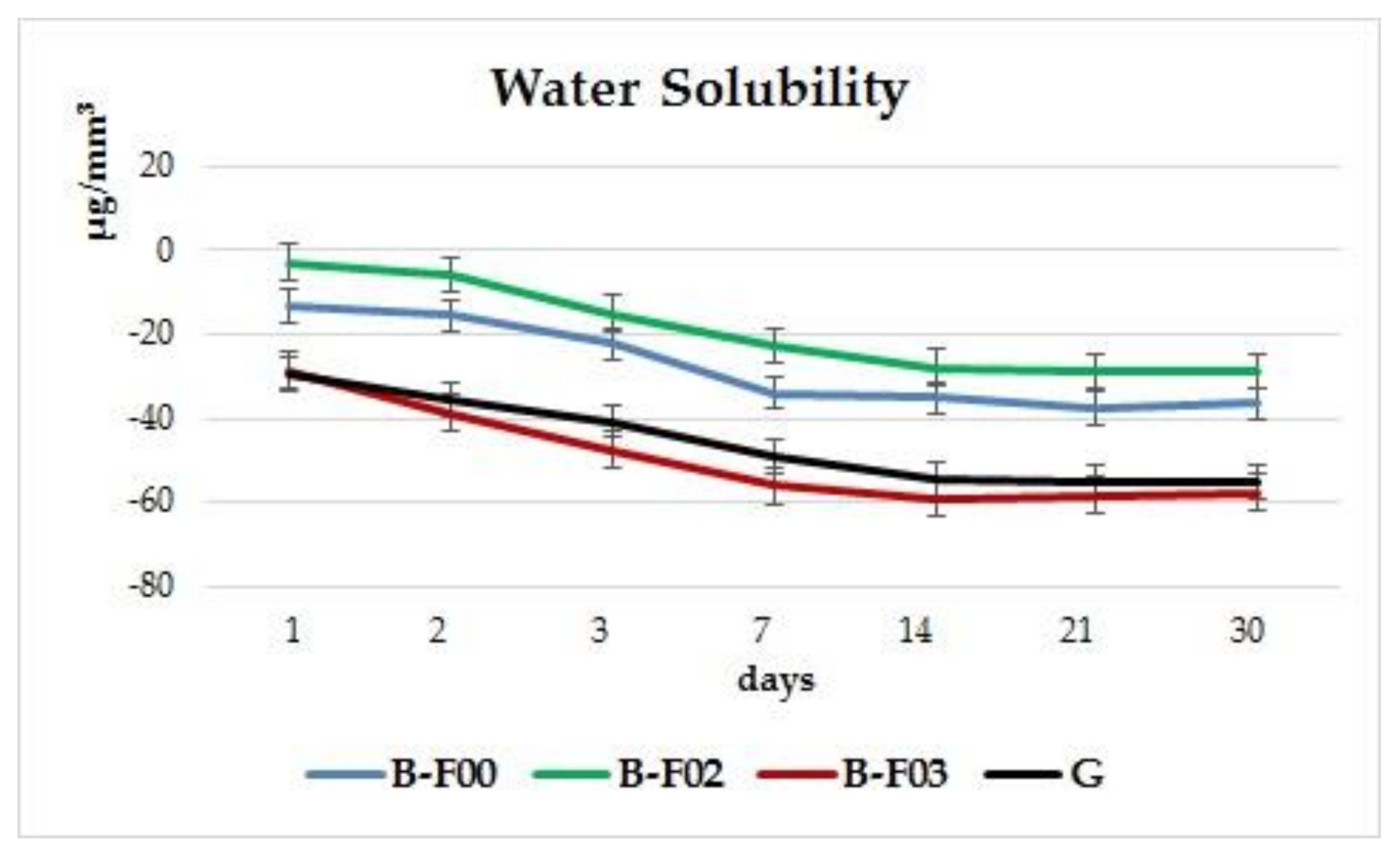
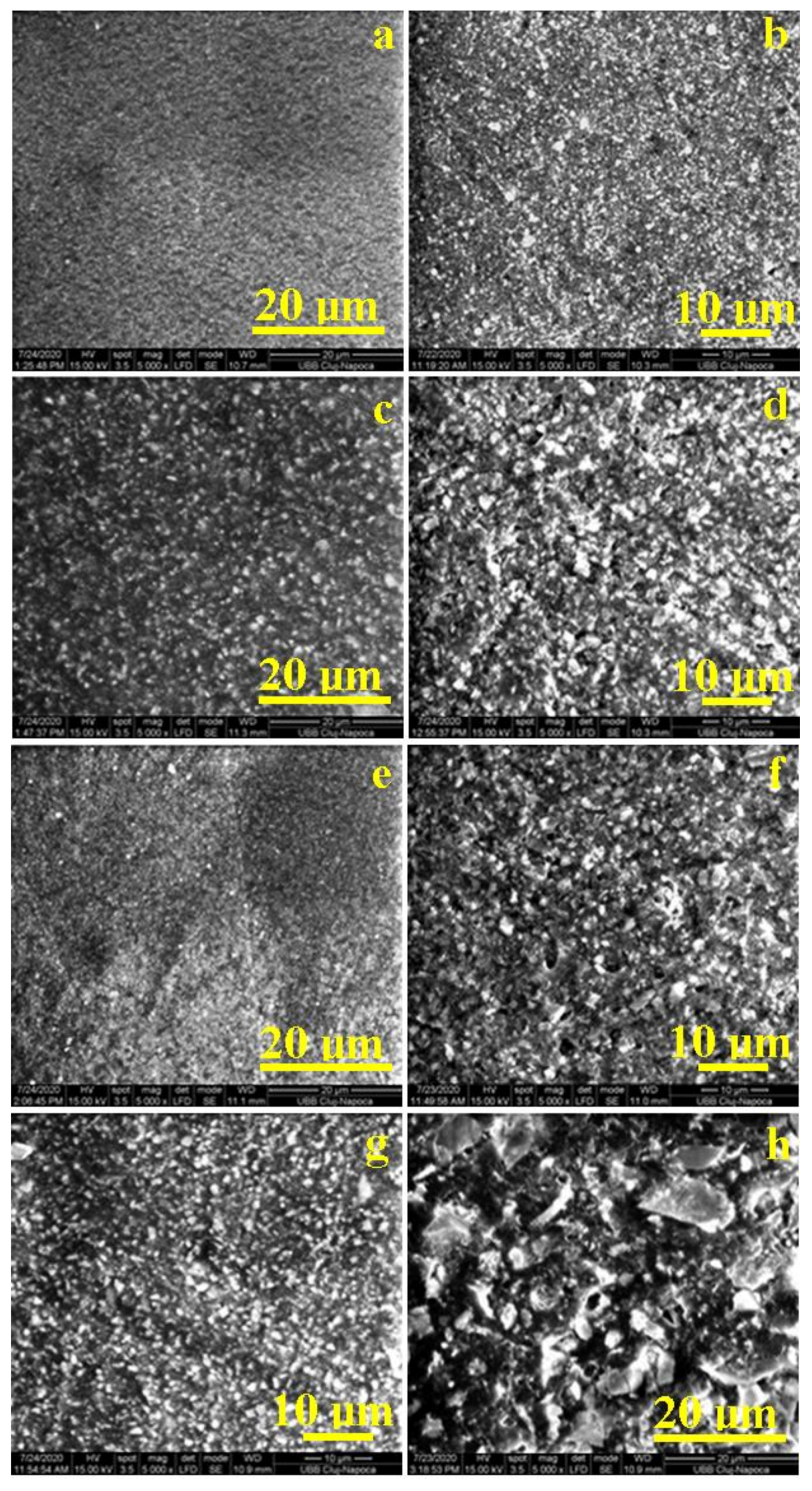
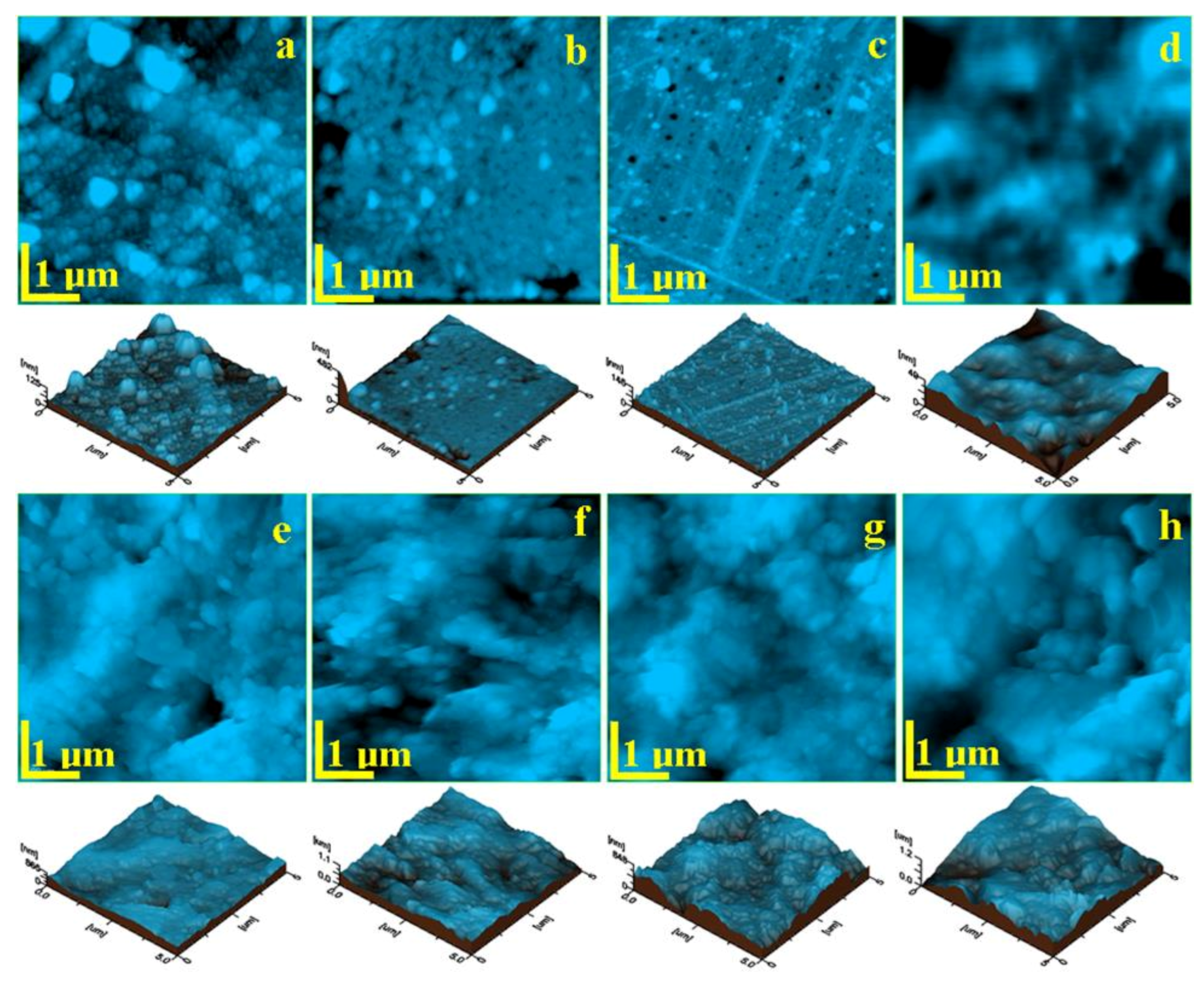
| Name | Consistency | Composition | Codification |
|---|---|---|---|
| Beautifil flow Plus X F00 | Minimal flow | 10–20%. Bis-GMA, TEGDMA, Bis-MPEPP, 50–60% S-PRG filler based on fluoroboroaluminosilicate glass, polymerization initiator, pigments and others | B-F00 |
| Beautifil flow F02 | Low flow | 20–30%. Bis-GMA, TEGDMA, 40–50% S-PRG filler based on fluoroboroaluminosilicate glass, polymerization initiator, pigments and others | B-F02 |
| Beautifil flow Plus X F03 | Low flow | 10–20%. Bis-GMA, TEGDMA, Bis-MPEPP, 50–60% S-PRG filler based on fluoroboroaluminosilicate glass, polymerization initiator, pigments and others | B-F03 |
| *Experimental giomer | Flow | 10–40%. *Bis-GMA, TEGDMA, 40–60% filler based on *Exp-glass, *SPRG, *FHAP, polymerization initiator, pigments and others | G |
| Samples | Ra Initial | Ra after 30 Days of Exposure (p-Value) | Rq Initial | Rq after 30 Days of Exposure (p-Value) |
|---|---|---|---|---|
| B-F00 | 11.88 ± 2.32 | 73.28 ± 18.27 (<0.05) | 17.34 ± 5.11 | 91.70 ± 22.59 (<0.05) |
| B-F02 | 14.49 ± 8.32 | 139.60 ± 24.69 (<0.05) | 20.77 ± 10.14 | 179.40 ± 31.35 (<0.05) |
| B-F03 | 9.96 ± 6.02 | 105.94 ± 14.74 (<0.05) | 13.854 ± 7.25 | 132.80 ± 16.72 (<0.05) |
| G | 5.16 ± 0.712 | 159.60 ± 34.10 (<0.05) | 6.50 ± 0.84 | 202.40 ± 39.11 (<0.05) |
ublisher’s Note: MDPI stays neutral with regard to jurisdictional claims in published maps and institutional affiliations. |
© 2021 by the authors. Licensee MDPI, Basel, Switzerland. This article is an open access article distributed under the terms and conditions of the Creative Commons Attribution (CC BY) license (https://creativecommons.org/licenses/by/4.0/).
Share and Cite
Rusnac, M.E.; Prodan, D.; Cuc, S.; Petean, I.; Prejmerean, C.; Gasparik, C.; Dudea, D.; Moldovan, M. Water Sorption and Solubility of Flowable Giomers. Materials 2021, 14, 2399. https://doi.org/10.3390/ma14092399
Rusnac ME, Prodan D, Cuc S, Petean I, Prejmerean C, Gasparik C, Dudea D, Moldovan M. Water Sorption and Solubility of Flowable Giomers. Materials. 2021; 14(9):2399. https://doi.org/10.3390/ma14092399
Chicago/Turabian StyleRusnac, Mara Elena, Doina Prodan, Stanca Cuc, Ioan Petean, Cristina Prejmerean, Cristina Gasparik, Diana Dudea, and Marioara Moldovan. 2021. "Water Sorption and Solubility of Flowable Giomers" Materials 14, no. 9: 2399. https://doi.org/10.3390/ma14092399
APA StyleRusnac, M. E., Prodan, D., Cuc, S., Petean, I., Prejmerean, C., Gasparik, C., Dudea, D., & Moldovan, M. (2021). Water Sorption and Solubility of Flowable Giomers. Materials, 14(9), 2399. https://doi.org/10.3390/ma14092399








